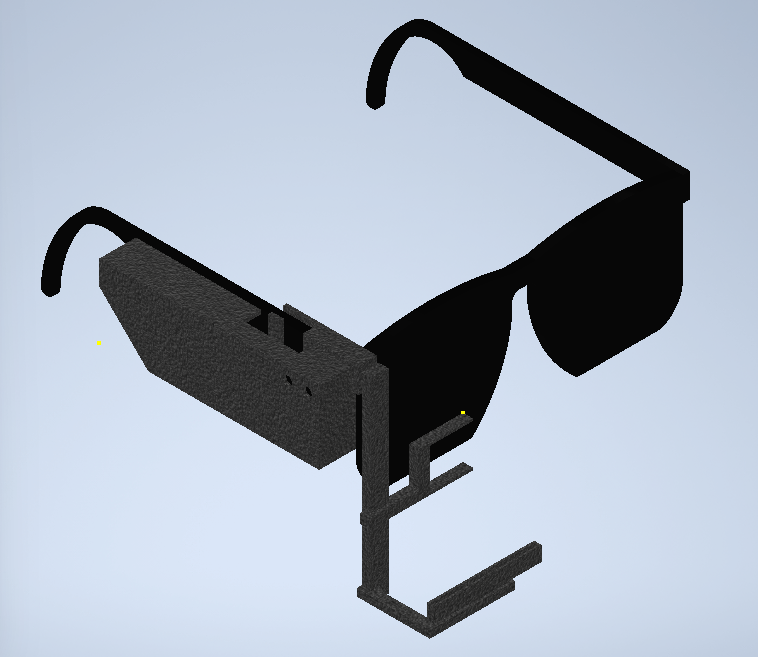Project Name: Translating Glasses
Project Functional Description:
Language barriers present significant challenges in the exchange of culture and information. Our project aims to address these obstacles by enabling seamless translation in a natural format via translation glasses.The design of the glasses will be as follows:
- Resin-dipped thick frame capable of indoor use
- Left lens missing from front frame cut-out
- Microphone embedded in right lens endpiece
- Small lens in right frame front magnifying a transparent OLED display extending out of right endpiece with adjustable arm
- Right temple containing thin and long rectangular PCB under resin with microphone wire routing to it from the right and wire to power cable entering on the left from the right temple tip
- Front top right corner of right temple containing two physical push-down buttons in series going in the direction of temple tip on PCB, sticking out of resin
- OLED screen controller spanning the height of the PCB on the temple tip (left) side of buttons on PCB with ribbon cable to OLED screen
- ESP32 microcontroller on the temple tip (left) side of OLED controller on PCB near the bottom edge
- Buck converter on the temple tip (left) side of OLED controller on PCB near the top edge with voltage divider circuit under it and wires leading to power socket on left side
- Power cable being detachable from socket leading to 6 AA battery enclosure capable of being clipped to user's belt

The intended use of the glasses will be as follows:
- Users will load 6 AA batteries into the battery enclosure in series and plug the power cable into the right temple tip of the glasses, where the buck converter will turn the 9V outputted to the 3.3V the system requires
- Users will turn on the translation, screen, and microphone by tapping and holding the two buttons together
- Users will check how much battery is remaining in the enclosure by holding the first button and reading the display
- Users will select the language the translated text will be in by clicking the first button, with the currently chosen language being displayed on the screen
- Users will select the text size they desire by clicking the second button, with sample text being displayed on the screen
- Users will use these text samples to adjust the display's distance from the right eye to ensure best legibility
- When on, the microphone will continually collect audio packets of a fixed size that are detected as speech and transfer to the ESP32 via its ADC
- The ESP32 will queue these audio packets in RAM until a fixed number of packets is reached
- The ESP32 will then transmit the audio packets in order to a computer via WIFI along with the chosen language
- The computer will run an API to translate the speech audio into text of the chosen language
- The ESP32 will use another core to ping for translated text received from the computer via WIFI at a fixed interval
- The ESP32 will queue the translated text in RAM until a fixed amount of text is reached
- The ESP32 will then transmit the translated text at a fixed size to the display where users can read it via SPI
Project Specific Design Requirements (PSDRs):
- PSDR #1 (Hardware): An ability to display text on the transparent OLED display sent from the microcontroller via SPI.
- PSDR #2 (Hardware): An ability to receive audio input from the embedded microphone and transfer to the microcontroller via its ADC.
- PSDR #3 (Hardware): An ability to measure the remaining battery level using a voltage divider circuit and the microcontroller's ADC.
- PSDR #4 (Software): An ability to transmit and receive packets between the microcontroller to a computer via WIFI protocols.
- PSDR #5 (Software): An ability to process and store received translation text packets in a text queue on the microcontroller.
- An ability to use the ESP32's bluetooth module to connect to a speaker for audible translation, requiring audio to be sent back from the remote computer rather than text.
- An ability to create and save a text log of the current conversation on the ESP32 that the user can share via WIFI.
- We can utilize natural language processing filters on the remote computer to perform better translation that is more personable.
- We can utilize a digital assistant API on the remote computer to allow the user to get tasks done that Siri or Google Assistant would on their phone.